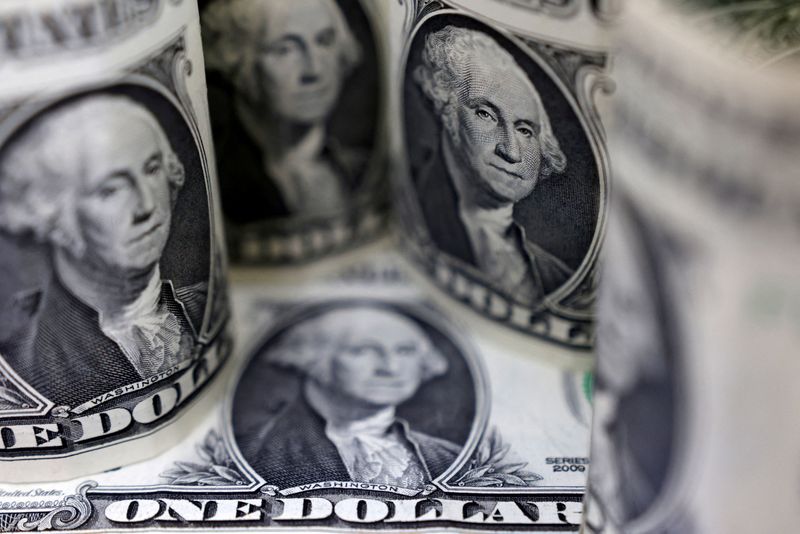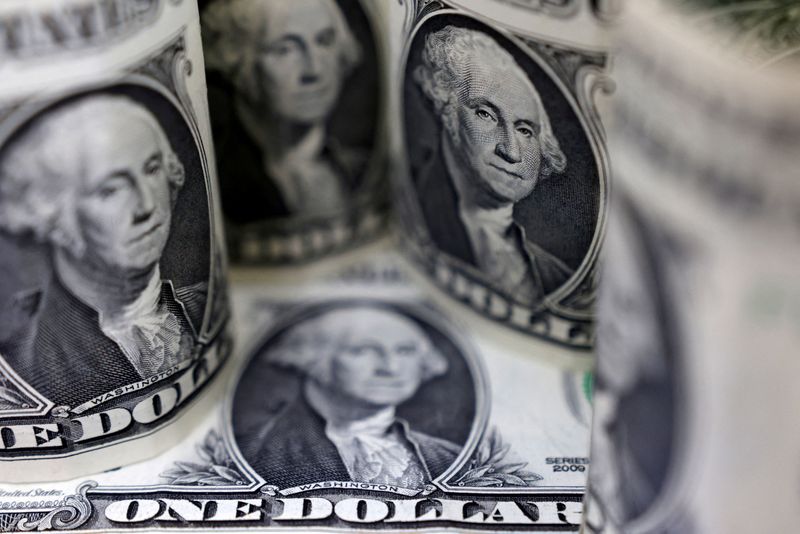Forex
Dollar falls, euro highest since August in thin holiday trading


© Reuters. FILE PHOTO: U.S. Dollar banknotes are seen in this illustration taken July 17, 2022. REUTERS/Dado Ruvic/Illustration/File Photo
By Karen Brettell
NEW YORK (Reuters) -The fell on Tuesday and the euro hit a more than four-month high as investors waited on fresh clues to when the Federal Reserve is likely to begin cutting interest rates as inflation falls closer to the U.S. central bank’s 2% annual target.
Volumes were muted the day after Christmas, however, as markets in the UK, Australia, New Zealand and Hong Kong, among others, were still out for a public holiday. Many traders globally are also out for holidays until the New Year.
The greenback is on track to post its worst performance since 2020 against a basket of currencies as anticipation of Fed rate cuts dents the appeal of the U.S. currency relative to peers.
Many analysts expect the U.S. economy to markedly slow in 2024, but the Fed is also expected to act to ensure that the gap between the fed funds rate and realized inflation doesn’t widen too far.
If inflation falls much faster than the Fed’s benchmark rate it can tighten monetary conditions more than Fed policymakers intend and increase the risk of a hard economic landing.
“Inflation should continue to cool, which will afford policymakers the ability to trim rates by June in order to prevent passive tightening in real rates,” analysts at Action Economics noted in a report on Tuesday.
However they pushed back against a cut coming as soon as March and disagreed with market pricing of 154 bps in easing by December, noting that this is “unlikely to be necessary unless the economy were to fall into a recession in coming months.”
Data on Friday showed U.S. prices fell in November for the first in more than 3-1/2 years, pushing the annual increase in inflation further below 3%.
Annual home prices in October rose again, pointing toward continued recovery of the housing market, data on Tuesday showed. Separately a Mastercard (NYSE:) report showed U.S. retail sales rose 3.1% between Nov. 1 and Dec. 24 as shoppers looked for last-minute Christmas deals amid big promotions.
The dollar index was last down 0.18% on the day at 101.44. It has fallen from a 20-year high of 114.78 on Sept. 28 2022 and is pace for a yearly loss of 1.98%.
The euro was up 0.20% at $1.1045, the highest since Aug. 10. The single currency has risen from a 20-year low of $0.9528 on Sept. 26, 2022 and is on track for a 3.08% gain this year.
The dollar gained 0.06% against the yen to 142.47. The dollar reached a 32-year high of 151.94 yen on Oct. 24, 2022, and came close to reaching this level again last month, before the Japanese currency recovered. The dollar is on pace for a 8.68% gain this year.
The yen has steadied near a recent five-month peak on the view that the Bank of Japan (BOJ) could soon mark an end to its ultra-easy policy. For most of 2022 and 2023, the policy has kept the Japanese currency under pressure as other major central banks embarked on aggressive rate-hike cycles.
BOJ Governor Kazuo Ueda said on Monday the likelihood of achieving the central bank’s inflation target was “gradually rising” and it would consider changing policy if prospects of sustainably achieving the 2% target increase “sufficiently”.
In cryptocurrencies, fell 3.36% to $42,130.
========================================================
Currency bid prices at 3:00PM (2000 GMT)
Description RIC Last U.S. Close Pct Change YTD Pct High Bid Low Bid
Previous Change
Session
Dollar index 101.4400 101.6400 -0.18% -1.981% +101.7700 +101.4500
Euro/Dollar $1.1045 $1.1015 +0.20% +3.08% +$1.1045 +$1.1010
Dollar/Yen 142.4700 142.4050 +0.06% +8.68% +142.6250 +142.0900
Euro/Yen 157.35 156.85 +0.32% +12.15% +157.3600 +156.5900
Dollar/Swiss 0.8532 0.8555 -0.27% -7.73% +0.8579 +0.8532
Sterling/Dollar $1.2722 $1.2699 +0.10% +5.16% +$1.2723 +$1.2689
Dollar/Canadian 1.3203 1.3268 -0.41% -2.56% +1.3262 +1.3202
Aussie/Dollar $0.6824 $0.6799 +0.24% +0.12% +$0.6824 +$0.6799
Euro/Swiss 0.9422 0.9423 -0.01% -4.78% +0.9448 +0.9419
Euro/Sterling 0.8679 0.8672 +0.08% -1.87% +0.8686 +0.8669
NZ $0.6331 $0.6298 +0.36% -0.29% +$0.6332 +$0.6295
Dollar/Dollar
Dollar/Norway 10.1360 10.2120 -0.57% +3.46% +10.2710 +10.1540
Euro/Norway 11.1980 11.2303 -0.29% +6.71% +11.3130 +11.2010
Dollar/Sweden 9.9919 10.0179 +0.17% -4.00% +10.0734 +9.9848
Euro/Sweden 11.0360 11.0175 +0.17% -1.02% +11.0935 +11.0100

 Forex3 years ago
Forex3 years agoForex Today: the dollar is gaining strength amid gloomy sentiment at the start of the Fed’s week

 Forex3 years ago
Forex3 years agoUnbiased review of Pocket Option broker

 Forex3 years ago
Forex3 years agoDollar to pound sterling exchange rate today: Pound plummeted to its lowest since 1985

 Forex3 years ago
Forex3 years agoHow is the Australian dollar doing today?

 Cryptocurrency3 years ago
Cryptocurrency3 years agoWhat happened in the crypto market – current events today

 World3 years ago
World3 years agoWhy are modern video games an art form?

 Commodities3 years ago
Commodities3 years agoCopper continues to fall in price on expectations of lower demand in China

 Economy3 years ago
Economy3 years agoCrude oil tankers double in price due to EU anti-Russian sanctions





















